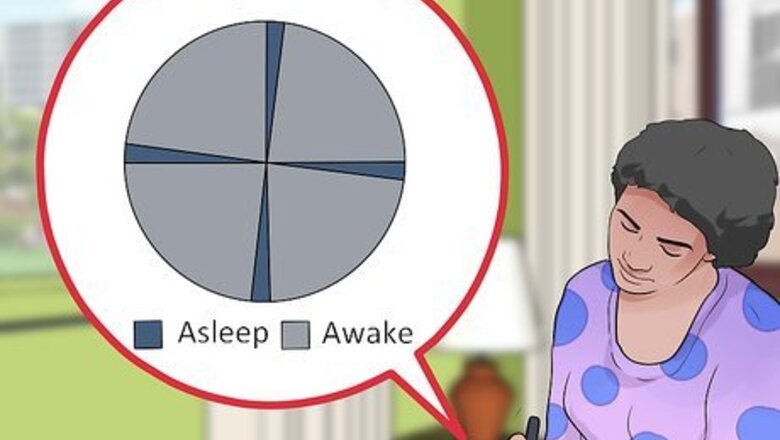
views
Maintaining Your Core Nighttime Sleep
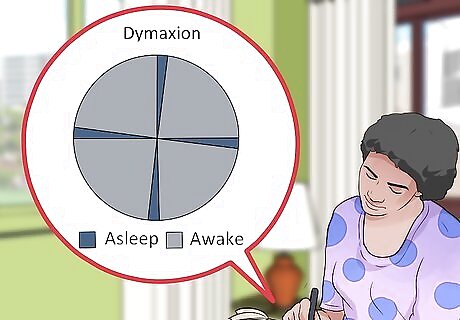
Choose a method. As you prepare to begin polyphasic sleeping, you will want to choose a method based on your goals, the flexibility of your schedule, and your body’s overall need for sleep. There are four primary documented methods for polyphasic sleeping. The four patterns include biphasic sleep, the Everyman pattern, the Dymaxion method, and the Uberman method. Two of the four include a schedule with the largest sleep segment occurring at night: biphasic sleep and the Everyman pattern. Starting with a pattern that includes core nighttime sleep may be the safest way to start. Adjust to sleep reduction gradually to minimize the problems associated with sleep deprivation.

Consider a biphasic sleep schedule. Biphasic sleep is basically dividing your sleep into two scheduled segments. Usually the longer segment is at night, and a scheduled nap of either 20 to 30 minutes, or 90 minutes, happens during the early afternoon. Many cultures use this pattern of sleep routinely, and this form of biphasic sleeping may actually be a healthy option. The shorter nap time serves as a refreshing sleep and helps to get past the natural early afternoon slump. The longer nap time allows the person to complete a full sleep cycle, including REM sleep. The circadian rhythm pattern and hormonal releases of chemicals that help regulate sleep also support a biphasic sleep pattern with the largest chunk of sleep occurring during the dark night hours. Biphasic sleep has been documented in history as first and second sleep. Prior to the days of electricity, people would sleep for a few hours immediately after nightfall, then get up for several hours and become active. They would then go back to sleep for their second sleep, and awake around dawn with first light. A biphasic sleep schedule may not be considered polyphasic for those that have goals of a significant reduction in the time they spend sleeping every 24 hours since this pattern of sleeping does not significantly reduce the total number of hours slept in a 24 hour period.

Create your own biphasic pattern. Depending on your sleep goals, the flexibility of your schedule, and your body’s need for sleep, you may benefit from creating a biphasic patterns that works best for you. Target two segments of time during each 24 hour cycle that you want to sleep. Allow for enough REM sleep time during each sleep segment. Most people require five to six periods of REM sleep every 24 hours. One normal sleep cycle, including REM sleep, takes about 90 minutes. Devise a schedule that incorporates the 90 minute cycles, and divide that into your two target sleep times. For example, you may want to have a core nighttime sleep schedule from 1am until 4:30am, then a 90 minute to three hour nap from 12 noon until 1:30pm or 3pm. Adjust your times according to the flexibility of your schedule. As you get used to your new schedule, gradually decrease the time you spend sleeping as long as you are not having problems. Always allow at least three hours between your sleep times. Do not oversleep and do not go to sleep early. Stick with your schedule for at least a week before you make changes.
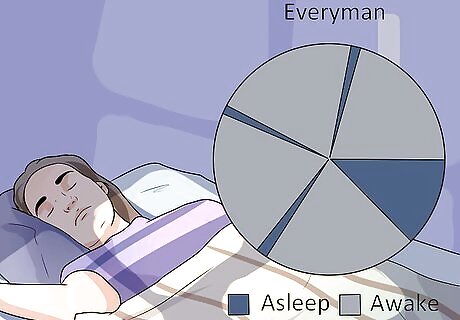
Adopt the Everyman schedule. The Everyman method consists of a nighttime core sleep period of about three hours plus three scheduled 20 minute naps. This is a good place to start with polyphasic sleeping since it still provides for the largest segment of sleep to occur at night, which is what most people are accustomed to. Set your target schedule. Determine the best time to have your core sleep of three hours based on your schedule. Typical choices would be either 1am to 4am, or 11pm to 2am. Depending on the timing of your core sleep segment, schedule your twenty minute naps accordingly. Allow for at least three hours between your nap times. For example, a schedule for the 1am to 4am core sleep would be to nap for 20 minutes at 9am, 2pm, 9pm, followed by the core sleep at 1am. For a core sleep of 11pm to 2am, you would nap at 7am, 12pm, and 6pm.
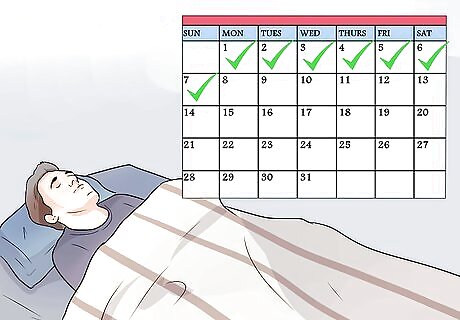
Transition gradually to your schedule. Maintain the initial schedule for about a week, but extend that time if you are having trouble adjusting. Next you can begin to break up your total five hours of sleep into three distinct segments. Maintain your core sleep segment at four hours, then reduce your naps to just two at 30 minutes each. If you work a regular 9am to 5pm job, schedule your naps at lunch and immediately after work, if that is possible. Stay with the adjustment for a week. Again, extend the time if needed so your body can adjust to the recent changes. At the beginning of your third week, or possibly a week or so later, add another nap while reducing both the amount of time per nap and the amount of core sleep. The final adjustment brings you to a core sleep time of 3.5 hours and three naps at 20 minutes each spread out throughout the day. Adjust your target sleep schedule bedtime and your nap times to fit your schedule.
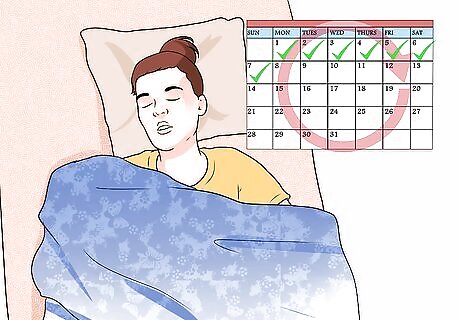
Maintain your new sleep schedule. Strictly follow your schedule, try not to oversleep, and get up on time. Try hard to resist sleeping just a few more minutes during your core time and your naps. Don’t get too stressed if you are having trouble. Becoming stressed will only make it harder to fall asleep quickly when you absolutely need to take advantage of every minute of scheduled sleep time. When you are on the Everyman schedule, stick to your core bedtime schedule and your nap times. Plan ahead. Have a plan for your newly found free time. It is unlikely that other people around you will be operating on the same schedule. Be organized and have a good “to do” list prepared. Focus on including those things you want to do but have not had the time. This will help to reinforce the value of your new sleep schedule and help you to stick with it.

Adjust the Everyman schedule to suit your needs. The most popular schedules include the core sleeping segment with three schedule naps. It is possible to tweak this schedule to meet your personal scheduling needs and adjust the amount of total sleep if needed. Other schedules that still fall within the Everyman method are available. One schedule includes decreasing the core night sleep segment to 1.5 hours with four to five 20 minute naps scheduled at equal intervals through the rest of the 24 hour period.
Eliminating the Core Night Sleep Segment
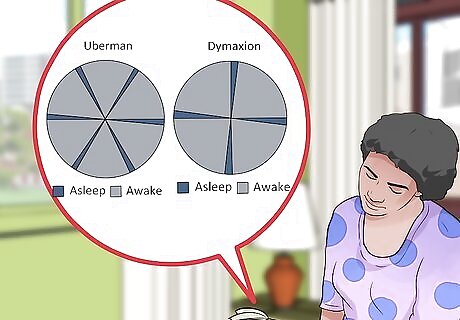
Review the Uberman and Dymaxion schedules. Both methods eliminate the core nighttime sleep segment. If you have adapted to the Everyman schedule and want to try an even more extreme sleep method that completely eliminates core sleep, consider the Uberman or the Dymaxion schedules. These both involve just two hours of sleep spread through the day. Both schedules have very limited flexibility with the need to adhere as strictly as possible to the schedule you develop. Carefully consider your work, school, and family schedule before you begin either sleep pattern. Both Uberman and Dymaxion include a total of two hours of sleep every 24 hour period.

Plan an Uberman schedule. The Uberman polyphasic sleep schedule involves six 20 minute naps placed at equal intervals, or every four hours. The schedule requires the ability to firmly commit to the structured sleep schedule. For example, sleep for twenty minutes at 1am, 5am, 9am, 1pm, 5pm and then 9pm. If you are trying to stick to this schedule it is essential that you get all of your naps. The Uberman requires a 20 minute nap every four hours. If you find yourself becoming very fatigued, struggling to maintain concentration or focus on tasks, you should immediately re-think your sleeping schedule.
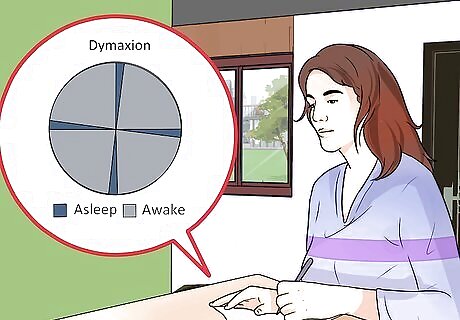
Consider a Dymaxion schedule. The Dymaxion schedule has the same amount of total sleep as the Uberman, but may be equally difficult to commit to. The Dymaxion schedule requires fewer but slightly longer naps. The Dymaxion strictly requires a 30 minute nap every six hours. The total 24 hour sleep time with the Dymaxion schedule is two hours. One possible Dymaxion schedule would be 30 minute naps scheduled at 6am, 12pm, 6pm and 12am. The Dymaxion pattern is reported to be the result of the sleeping patterns of Buckminster Fuller, a renowned 20th century architect, author, and inventor. It is also said he gave up this sleeping pattern to spend more time with his family.
Preparing Yourself for Polyphasic Sleeping

Learn to nap. The main principle of polyphasic sleeping is to break up your sleeping into short intervals during the day. When added together these naps will still equal much less than you would get from a normal sleeping pattern. To sustain this type of sleeping pattern, you need to get the most possible benefit from every scheduled sleep segment and nap. Train yourself to nap by getting up earlier than normal, and allowing yourself to give in to that sleepy feeling that usually occurs around midday. Avoid computer screens and bright lights for at least 15 minutes before you plan to nap. Nap at the same time everyday so your body can get adjusted to the new routine. When you lie down to nap, focus on lowering your heart rate. Count it for 60 beats, then listen to it for another 60 beats. Once your heart rate slows, work on clearing your mind. Set an alarm and don’t snooze. Get up as soon as the alarm goes off.

Cut back on your nightly sleep. It is not easy to jump straight into polyphasic sleeping. Ease yourself into this method of sleeping by gradually reducing the hours you sleep every night. Begin by cutting three hours per night from your regular sleep schedule. Instead of sleeping for eight hours per night, sleep for five hours instead. Stick with your reduced nightly hours of sleep for three days.

Set alarms and adhere to your sleep schedule. You may feel quite sleep-deprived during this initial adjustment phase, but adopting a rigid approach to sleeping and waking up on time will speed your adjustment. Place your alarm clock away from your bed so that you actually have to get out of bed to turn it off. Turn on the light on as soon as you wake up. If you have access to a lamp or alarm clock that mimics natural light, use that as a light source to help you wake up after each sleep segment.

Consider your schedule. As you work towards identifying the best method for you, think about your work, school, family, church, and athletic activity schedule to be sure you select the best pattern for you. Remember, you have to strictly adhere to the schedule you select to make this work. Also consider the fact that the rest of your world is not likely to be on your new sleeping schedule. Be sure you have the means and the desire to work around the schedules of your close friends and family. Don’t forget about sports and unplanned events that may not be on your schedule. Be sure you are ready to pass up some opportunities.

Pay attention to key scheduling factors. You may choose to follow an existing sleeping pattern or to tweak one to suit your own needs. Either way, be aware of some key factors that are critical to the success of your new sleeping pattern. Be sure the schedule includes the opportunity for at least 120 minutes of total REM sleep time every 24 hours. Build in at least 3 hours between sleep segments. Distribute your sleep segments as evenly as possible over the 24 hour period. Identify the best times to nap. If you are unsure of this, then work backwards and identify the best times not to nap. Work in increments of 90 minutes to begin with in scheduling your core sleep segments.
Understanding the Risks

Consider speaking to your doctor first. Getting enough sleep is essential to your general health and well-being. Polyphasic sleep has not been proven to be safe and may do harm, especially if other medical conditions are present or if your daily activities involve driving or operating machinery. If you have existing medical conditions or concerns, or are currently taking prescription medications, be sure to discuss your desire to alter your sleep pattern with your doctor. Have a solid plan to safely transition your sleep and be prepared to provide information regarding the potential benefit of trying a polyphasic sleep method prior to your conversation with your doctor. Based on the limited amount of scientific evidence that supports the use of polyphasic sleeping specific to general health measures, be prepared for your doctor to be against it.

Reconsider if you develop problems. Before you start on your schedule changes to implement polyphasic sleeping, have a clear understanding of the short- and long-term possible complications. Many sleep experts consider polyphasic sleep as a form of sleep deprivation. Have someone that supports you in this effort be available to help you evaluate any possible changes that might be harmful. One of the first and very serious considerations is to closely monitor your ability to drive and/or operate machinery during the first few days and weeks as you begin to introduce a reduction in your amount of sleep. Documented concerns with sleep loss include drowsy driving, automobile accidents and injury to self and others, and occupational accidents and injury to self and others.

Recognize short-term problems. Consider the possibility of the short-term effects of sleep deprivation in all aspects of your life before you begin. Sleep loss can rapidly cause problems with anxiety, forgetfulness, impaired memory, impaired cognitive function, distractibility, difficulty focusing and staying on task, and stressed relationships. Short-term sleep loss may lead to occupational or automobile injury, harming not just yourself, but others, too. Sleep deprivation has been linked to serious accidents, including nuclear reactor meltdowns, grounding of large ships, and aviation accidents. This has led to changes in the trucking and airline industry, which requires airline pilots and truck drivers to have normal sleep patterns. Other common complaints related to sleep loss include difficulty with making decisions, timeliness, foggy and confused comprehension, clumsiness, feeling grumpy and argumentative, and trouble paying attention to others during conversations.

Identify the long-term consequences of sleep deprivation. The science behind sleep is still not clearly understood, but many long-term risks associated with sleep deprivation have been discovered. Long-term sleep deprivation can lead to high blood pressure, heart attack, heart disease, stroke, obesity, diabetes, epilepsy, and a shortened life expectancy. Psychiatric problems can develop and include depression and mood disorders. Other problems include a disruption of the quality of sleep of a spouse or bed partner, and overall poor quality of life. If you feel fatigued, are moody, irritable, unable to carry out your normal life, or experience any of the symptoms associated with sleep loss or sleep deprivation, reconsider your speed of transition or you overall plan entirely. Consider even a short reduction in your total sleep regimen as being a success provided you are still getting the sleep your body needs.



















Comments
0 comment